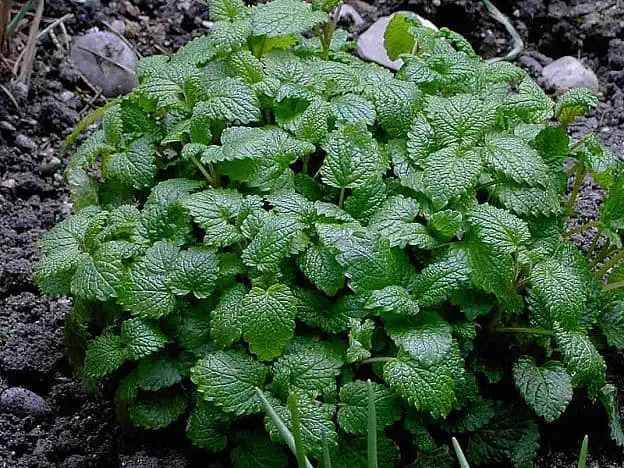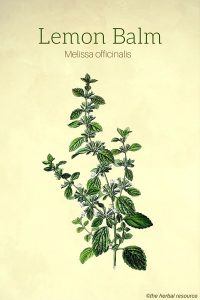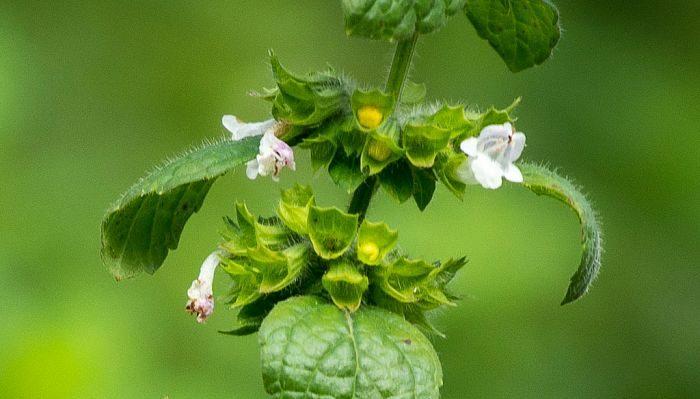Scientific Name: Melissa officinalis.
Other Common Names: Common balm, melissa, sweet balm, citronmeliss (Swedish), Melisse (German), meliza (Spanish).
Note that ‘bee balm’ is sometimes used, incorrectly, as a synonym for lemon balm; bee balm is, in fact, another group of plants in the mint family.
Distribution and Habitat: Lemon balm, a member of the mint family, is native to western Asia and was introduced centuries ago to central and southern Europe, where it is now common.
Lemon balm was also introduced to eastern North America and is now naturalized through much of that range as well as parts of the Pacific coast.
Lemon balm thrives in a wide range of conditions. It spreads both vegetatively and by seed. It is a hardy, easy to grow plant that can become weedy in the garden.
There are several varieties of Melissa officinalis in cultivation in Europe, most notably “citronella”, “lemonella”, and “quedlinburger”.
The herb is of commercial importance as a food flavoring and medicinal plant.
Description: Lemon balm is a perennial herb. The leaves look very much like the leaves of other mints: tender, oval, toothed and slightly heart-shaped and bright green in color.
The pleasant, lemon aroma of the plant is obvious when the leaves are rubbed or crushed. Lemon balm grows to a height of about 60 cm (two feet).
If uncut through summer the stalks will produce small white flowers that are attractive to bees. The plant spreads vigorously by root as well as seed.
Over 100 chemicals have been isolated from lemon balm and among these the most biologically active may be its aromatic oils: citral, citranella, linalod and geraniol, as well as these classes of compounds: flavonoids, phenolic acids, terpenes, roasmarinic acids and caffeic acids.
Plant Parts Used: As with most medicinal plants in the mint family, the beneficial extracts are made from the oils contained in the leaves of the plant, and the oils are easily extracted just by crushing the leaves.
As with other mints, the leaves are used whole or chopped to make tea.

Therapeutic Uses and Benefits of Lemon Balm
As with any herbal remedies, the traditional claims of the healing power and health benefits of lemon balm should be assessed alongside the available scientific and clinical evidence.
It has long been cultivated as a beneficial plant and is purported to have several healing effects. It was known to the ancient scholars Hippocrates and Dioscorides and is mentioned in the Bible.
Some of the long-standing claims made about its medicinal properties have been investigated in recent years in the laboratory and in a few clinical trials.
The commonly cited traditional uses of lemon balm as an herbal remedy are several:
- – in aromatherapy, for its calming effect,
- – as a topical insect repellent,
- – as a mild digestive aid, and
- – as general pain medicine.
Other folk uses include treatment of asthma, bronchitis, and urinary incontinence.
Recently studied medicinal benefits of lemon balm include:
- – sedative effect,
- – treatment of certain bacterial and viral infections, and
- – as a mild digestive aid, and
- – treatment of cognitive function loss in Alzheimer’s.
It is natural that the well-knowing calming effect of lemon balm would have led to medical study of this property.
In at least one clinical study, doctors have reported the safe and effective use of the herb as an aromatherapy in treating agitation in elderly, institutionalized patients suffering from dementia.[adinserter block=”9″]
Lemon balm also appears promising as a treatment to slow the progress of Alzheimer’s disease. The mode of action appears to be antioxidant activity in the brain.
There has been at least one clinical trial showing an actual significant improvement of cognitive function in Alzheimer’s patients.
The authors of this study were quick to point out that theirs may be the first such clinical trial (in 2003) and more clinical studies are required to confirm the effectiveness of lemon balm as an herbal remedy for Alzheimer’s.
A literature review in 2006 did not uncover any other clinical studies testing lemon balm on Alzheimer’s patients.
In contrast, there is a very persuasive volume of evidence for the effectiveness of Melissa officinalis in treating certain types of viral infection.
The herb seems best suited for treating herpes simplex.
This has been known for several decades — the first laboratory evidence was in 1957 and more recent studies continue to support the effectiveness of lemon balm compounds in treating herpes simplex.
Interestingly, as noted by Dr. Linda White, because chronic fatigue syndrome may in some cases be caused by the herpes virus, treatment with lemon balm can help with chronic fatigue.
Lemon balm is not a universal anti-viral agent. Its mode of action in combating viral infection appears to differ depending on the type of virus and the compounds isolated in the research.
Geuenich and colleagues showed that lemon balm, as well as some other plants in the mint family, can inhibit the replication of the HIV-1 virus. On the other hand, it was not found to be effective in treating rotavirus infection (a virus that causes severe diarrhea in children).
It should be stressed that one chemical or group of chemicals derived from the plant may be active against one type of virus while a different chemical may be effective against another virus.
For example, a tannin found in Melissa officinalis is effective against mumps, while an extract that is tannin-free has been found to be effective against herpes.
As can be seen from the history of lemon balm, the well-established traditional use of a healing plant often prompts more in-depth study in the laboratory and confirmation of medicinal properties.
Anyone interested in using lemon balm to treat serious diseases such as Alzheimer’s, dementia, and viral infection, should consult with a medical doctor.
Dosage and Administration
Instructions on how to prepare lemon balm differ among herbalists. As with every herbal medicine, a qualified professional should be consulted before treatment.
In aromatherapy (to calm nerves and improve mood) the oil can be used much like the way lavender oil is used.
One can use the pure essential oil by dabbing some on a fabric sachet to a place near the bedside.
There are also skin lotions available.
As a topical treatment for insect bites and skin irritation from minor infection: a compress may be used.
A compress is made by steeping the leaves in hot water for a few minutes, and wrapping the leaves, once cooled, in a clean cloth or gauze.
As a tea, using one to five grams (one to two teaspoons) of dried leaves, it may be consumed several times a day. Lemon balm is also available commercially in capsule form.
Capsules are typically 300-400 mg each. Some herbalists state that it is safe to take as many as 9 capsules a day; however, a medical doctor should be consulted before taking lemon balm in prepared forms.
Side Effects of Lemon Balm
Lemon balm, in its traditional form of infusion (tea) or as a topical oil, is generally considered a mild and safe remedy.
Intoxication from this mild herb would be expected to be very rare. There has been at least one case of an overdose linked to one of the compounds in lemon balm, carbachol.
A person obtained a highly concentrated form of this one ingredient (carbachol) and this proved to be nearly fatal because of the unnaturally high dose ingested.
Unqualified persons should never attempt to acquire and self-administer concentrated forms of any active ingredient from a medicinal herb.
Supporting References
Gleason, H. A., and A. Cronquist. Manual of Vascular Plants of the Northeastern United States and Adjacent Canada. (2nd Ed.) New York: New York Botanical Garden, 1991.
US Department of Agriculture (USDA) Natural Resource Conservation Service. Plants Database.
Herb Society of America. Lemon Balm: An Herb Society of America Guide. Kirtland, Ohio, USA: Herb Society of America, 2007.
Karch, S. B. (MD). The Consumer’s Guide to Herbal Medicine. New York: Advanced Research Press, 1999.
World Health Organization (WHO). WHO Monographs on Selected Medicinal Plants. (Vol. 2)
Ballard, C. G., J. T. O’Brien, K. Reichelt, and E. K. Perry. Aromatherapy as a safe and effective treatment for the management of agitation in severe dementia: the results of a double-blind, placebo-controlled trial with Melissa. J Clin Psychiatry. 2002 Jul; 63(7): 553-558.
Bayat, M., A. A. Tameh, M. H. Ghahreman, M. Akbari, S. E. Mehr, M. Khanavi and G. Hassanzadeh. Neuroprotective properties of Melissa officinalis after hypoxic-ischemic injury both in vitro and in vivo. DARU J. Pharm. Sci. 2012; 20(42).
Akhondzadeh, S., M. Noroozian, M. Mohammadi, S. Ohadinia, A. H. Jamshidi, and M Khani.. Melissa officinalis extract in the treatment of patients with mild to moderate Alzheimer’s disease: a double-blind, randomized, placebo controlled trial. J. Neurol. Neurosurg. Psychiatry 2003; 74: 863–866.
dos Santos-Neto, L. L., M. A. de Vilhena Toledo, P. Medeiros-Souza, and Gustavo Almeida de Souza. The Use of Herbal Medicine in Alzheimer’s Disease—A Systematic Review. Evidence-Based Complementary and Alternative Medicine 2006; 3(4): 441-445.
Allahverdiyev, A, N. Duran, M. Ozguven, and S. Koltas. Antiviral activity of the volatile oils of L. Against virus type-2. Phytomedicine 2004; 11(7-8): 657–661.
Schnitzler, P, A. Schuhmacher, A Astani, and J. Reichling. Melissa officinalis oil affects infectivity of enveloped herpesviruses. Phytomedicine 2008 15(9): 734–740. [12] Kucera, L. S., R. A. Cohen, and E. C. Herrmann. Antiviral activities of extracts of the lemon balm plant. Ann. NY Acad. Sci. 2006; 130(1): 474–482.
White, Linda B. (MD) and Steven Foster. The Herbal Drugstore. New York: Rodale, 2000.
Geuenich, S., C. Goffinet, S. Venzke, S. Nolkemper, I. Baumann, P. Plinkert, J. Reichling, and O. T. Keppler. Aqueous extracts from peppermint, sage and lemon balm leaves.
Thordur Sturluson
Latest posts by Thordur Sturluson (see all)
- What is the Difference Between Hemp and Marijuana? - June 3, 2019


Leave a Reply